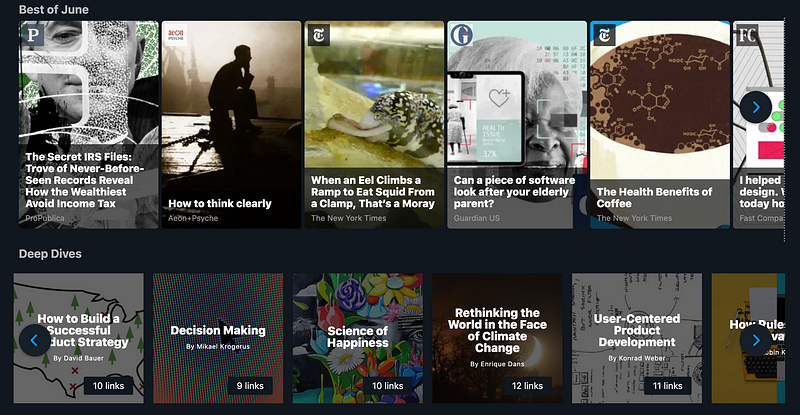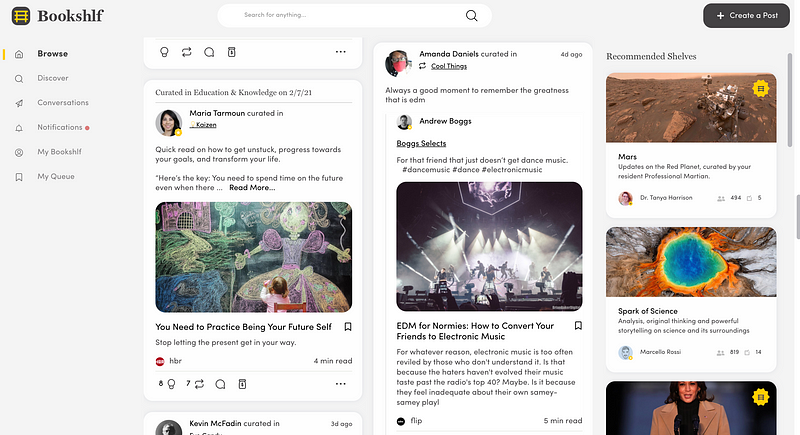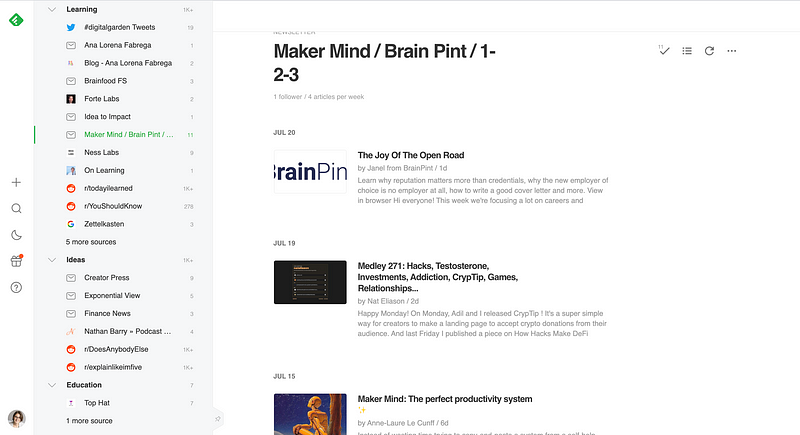All of them are free.

With fluff-flooded feeds, finding unique content can be tricky. As a creator, you probably know how difficult that can be.
When I started writing, I wasted much research time on social platforms. In the end, I was rarely satisfied with the results.
But discovering inspiring resources doesn’t need to be complicated. There are reliable, free platforms designed for online creators.
Here are my top three sources for content inspiration. Every single one can improve your creative process.
1) Refind — the 5 most relevant links.
The site helps you find the best from all around the web, tailored to your interests, curated by experts and algorithms.
You follow your favorite topics, sites, thought leaders, and friends, and Refind puts together the most relevant new links and key takeaways for you. Every day you see 5–10 new content pieces. I use Refind as a key inspiration for my weekly newsletter.
In addition, you can also subscribe to Deep Dives. Dozens of experts introduce you to the best articles and videos from their field of expertise.
For example, I created a deep dive on ‘How to build a writing habit’ with ten time-tested articles and videos from around the web. Any creator can curate a deep dive and get boosted to an audience who would otherwise not have found them.
How you can use it:
Sign up for free here and select your favorite creators and industries. Once the platform knows your preferences, you’ll receive 5–10 relevant links each day.
Whenever you find something valuable, you can organize your links within your collections— for yourself or the web.

2) Bookshlf —curation by humans.
Bookshlf is a place designed for curious learners who share their knowledge in public.
So-called shelves are curated link collections. A single Shelf can be organized by topic, mood, category, or media type, or in any other way that makes sense to you. As a result, the platform is filled with diverse content across industries.
Most curators post 20% self-created content, like their podcasts, videos, articles, and 80% resources. You can find things that alter your mindset, your understanding or get you to look at the world from a new angle.
I’ve used the platform since January 2020 to discover and organize content. I created shelves around my writing topics. On my profile, you’ll find shelves for education & learning, entrepreneurship, and creativity.
How you can use it:
You can sign up free here. Browse the Shelves and communities that trigger your interest. Subscribe to Shelves and follow your favorite curators to access exciting and relevant content easily.
You can also create your Shelves and get tipped by other users.

3) Feedly — smarter news reader.
Feedly is an online service that uses artificial intelligence to cut through the noise and flag specific topics and trends you care about from all the sources you trust. In essence, it’s an RSS feed aggregator.
While Refind and Bookshlf started recently, Feedly has been around since 2006. The platform is used by +15 million curious minds.
I started with Feedly in 2014 and upgraded to the premium version four months ago. For $99/year, I have all newsletters, favorite Twitter feeds, and blogs in one place.
How you can use it:
You can sign up free here. Just like Refind and Bookshlf, Feedly is free — and if you’re happy with limited functionality, it can stay free forever.
Feedly is less intuitive than Refind or Bookshlf. First, you want to find and organize the right sources. Second, train the AI assistant Leo to filter out the noise (which I haven’t managed to do yet). Then, you can read through your curated feed.

In Conclusion
Managing and discovering content doesn’t need to feel difficult. These three tools help you organize, curate, and find the content you love:
- Refind — the 5–10 most relevant links tailored to your interest.
- Bookshlf — a digital library from curators for curators.
- Feedly — an RSS feed aggregator to have everything in a single place.
I rely on all three content discovery tools, but right now, Refind is my favorite (it’s free, but I like it even better than my paid Feedly).
Instead of feeling discouraged by all these ways to find new content, experiment at your own pace. Try the platforms that resonate with you, and screw the rest.
Choose one or two new content resources until you find a pattern that helps you to become a better content creator.
Want to feel inspired and improve your learning?
Subscribe free to The Learn Letter. I read a book and 50 articles a week, and each Wednesday, you’ll receive the best in your inbox. This newsletter will make you find tools and resources that help you on your path to health, wealth, and wisdom.